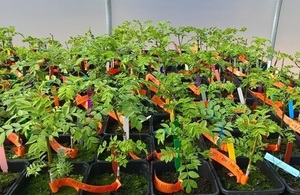Disease-tolerant trees to be planted in UK’s 'ash tree archive'
Biosecurity Minister launches Government's new Ash Research Strategy

Collection of young ash trees which will form part of the UK's first 'ash tree archive' [Credit: Future Trees Trust]
Ash trees demonstrating tolerance to the highly destructive tree disease ash dieback will be planted in the UK’s first ‘ash tree archive’.
This was announced by Biosecurity Minister Lord Gardiner at Royal Botanic Gardens Kew’s Millennium Seed Bank today (Thursday 6 June) as he launched the Government’s new Ash Research Strategy.
This strategy consolidates all the evidence on ash trees and their threats to identify future research needs to protect the species and restore it to our landscape. These threats include the tree disease ash dieback, which has the potential to cause significant damage to the UK’s ash trees population, and the pest emerald ash borer.
Defra has jointly funded a number of successful research projects that have identified trees which appear to be showing signs of tolerance to ash dieback. These trees are the next important step in developing a future breeding programme of disease-resistant ash trees.
Lord Gardiner, Biosecurity Minister, said:
Today is a day to acknowledge the sound progress that has been made and I am delighted that we are launching a Vision and High Level Strategy for Ash Research. This document lays out priority themes for research and, in the longer term, how it will deliver the restoration of our landscapes.
Defra is already committed to funding several key research activities. Just one innovative example is the ongoing screening by Forest Research and Future Trees Trust for ash trees tolerant to ash dieback. In early 2020 the Trust will be planting an archive of tolerant trees which will be a key resource for a future breeding programme.
Nicola Spence, Defra Chief Plant Health Officer, said:
Since ash dieback was identified in 2012, we have invested more than £6m in ash dieback research and £4.5m to strengthen border security. We currently have some of the strongest import controls in Europe.
But we want to go even further to protect our ash trees which is why we have developed the ash research strategy, a new document which will help us determine how to ensure ash trees remain in our landscape for future generations to enjoy.
Scions collected from the trees that appear to be showing signs of tolerance to ash dieback have been grafted onto healthy rootstock and are currently growing in nurseries with the anticipation of being planted in Hampshire in 2020.
The Ash Research Strategy has been developed in partnership with key stakeholders, including academics, Defra family scientists and researchers, research councils, the forestry, horticultural and landscape sectors, landowner representative bodies, environmental organisations.
Jo Clark, Head of Research at FTT and project lead for the Living Ash Project, said:
We are really excited to be working with Forest Research and Defra. These trees show a high degree of tolerance to ash dieback and have been sourced from trials and stands right across the country. The forest industry has come together to help identify these trees for future breeding work.
Professor Melanie Welham, Executive Chair of the Biotechnology and Biological Sciences Research Council, said:
BBSRC has continued to work with Defra, co-funding new research on ash dieback over the last few years. I am pleased to see the creation of the Ash Research Strategy and am confident the results from on-going studies will contribute to protecting one of Britain’s most important and beloved trees.
The ash strategy presents six updated ash policy objectives, set against the THRS resilience circle segments:
- Continuous review of pests and diseases which pose a threat to ash, in particular ADB and EAB;
- Mitigate the risk of further pest and disease outbreaks on ash;
- Ensure preparedness and an optimal response to an EAB incursion;
- Reduce the impact of ADB on ash-associated biodiversity and public health and safety;
- Restore ecosystem services, by repopulating the treescape with alternative species to ash;
- Assist the long-term survival of native ash in the landscape.